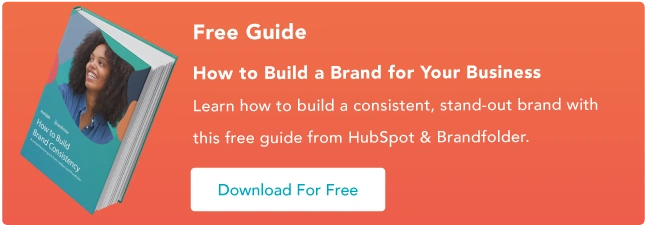I became a marketer because I love storytelling — a craft that I and many other content strategists treat like an art. Like all art, storytelling requires creativity, vision, skill, and practice. The result of this discipline? Marketing campaigns that really pull your audience in.
When I think about storytelling in business, my mind goes to an ad from makeup brand e.l.f. Cosmetics.
Instead of a traditional product showcase, the video was structured like a true crime documentary where the characters search for stolen makeup. Instead of clicking off after five seconds, I watched all 15 minutes. I was invested in the story.

Your audience, and humans generally, are drawn to stories. To help you tell better tales and connect with more customers, I’ve created the ultimate guide to storytelling in marketing and business. Pick up your pen, and let’s dive in.
Chapters
What is storytelling?
Storytelling uses words to create new worlds and experiences in a reader or listener's imagination. Storytelling can impact human emotions. It can also lead people to accept original ideas or encourage them to take action.
The Art of Storytelling
Since the dawn of human language, storytelling has been how cultures pass on shared beliefs and values. Some of the stories told today come from stories our ancestors shared over 6,000 years ago.
I love to think about our ancestors gathered around a fire to share their oral histories. Storytelling today, of course, looks a little different. In fact, I often feel bombarded by stories. I see it in the TV shows I love, the videos I scroll past on TikTok, and, of course, the up to 400 ads I can encounter daily.
So, how do you stand out through all of the noise? Here are the elements that I see in every compelling story. With a grasp of these concepts, you can start the process of transformative storytelling.

Free Brand Building Guide
A comprehensive guide to effectively define, launch, scale, and monitor your brand.
- Understanding brands today.
- Incorporating brand in marketing.
- Creating brand strategy.
- Measuring brand impact.
Download Free
All fields are required.

Narrative
All great stories have a narrative, or the spoken or written account of events that are influenced by a setting. You’re looking to build a tale with a beginning, middle, and end.
Let’s dive into an example. One of my favorite comedians is Hasan Minhaj. His first stand-up special shares his experience growing up in Davis California, focusing heavily on childhood and high school.
He has jokes throughout, but the over all narrative is a coming-of-age story. I wanted to watch the whole set, not just clips, because of the overarching narrative.
It can be tough to build a narrative in a condensed space. When I’m creating the narrative of a short ad or social video, I think of crafting a hook, a series of events, and a conclusion. Each section may only be a few sentences (or words), but I can still incorporate each element in my narrative.
Attention-Grabbing
Just telling a story isn’t enough — you want one that resonates and grabs attention.
One great way to do so is to create suspense. This tension attracts audiences with unanswered questions and an interest in learning more. Surprising your audience is also a great way to pull readers in.
Let’s look at this 2023 ad from HubSpot. When I think about a CRM, I think about offices, computers, monitors, and meetings. Instead, this ad staring Kathryn Hahn is set in the wild west. She compares the ease of using HubSpot to opening a saloon door. I found this ad memorable because it was so unexpected.
@hubspot HubSpotCRM: Easy to use. And flexible, too! Just like these saloon doors. #HubSpot
♬ original sound - HubSpot
Another way is to “show, don’t tell,” where you captivate your audience with details that bring your story to life. You don’t even need to have a full paragraph devoted to your ad.
In early 2024, I was taking a drive when Apple’s most recent campaign caught my eye. The brand often creates “shot on iPhone” ads that show professional photos taken from the device. What really caught my eye this time were the cute, high-quality portraits of babies making the most adorable expressions.
Through this campaign, Apple can tell a story with just a picture and the phrase “shot on iPhone.” We can imagine a parent wanting to capture life’s precious moments and can see that an iPhone can get the job done.
Interactive
Storytelling isn’t just the story you tell — it’s how your audience responds and engages. Some kinds of storytelling require people to participate in the story, like the Netflix interactive show Kaleidoscope, where viewers customize the order in which they watch episodes.
However, with most stories, the interaction comes from the relationship the audience builds with the storyteller. Your audience might be Swifties or Disney adults. And your favorite storyteller could be a TikTok influencer. That feeling of connection and interaction is essential to storytelling.
Let’s look at an example. Jordan Lipscombe is a beauty influencer with over 1.7 million TikTok followers. In this paid ad, she speaks directly to the audience, creating a sense of interactivity.
She even holds out her hand to high-five the audience watching on their phones. She even responds to comments to foster that relationship.
@jordanlipscombe AD | smoky NEVER disappoints @BEAUTY BAY 🩶💨🖤🌩️ exclusive launch on my TTS👀 #fyp #makeuptutorial #beauty
♬ original sound - Jordan
Imaginative
Again, we are bombarded by both stories and advertisements, so you need to be creative to stand out from the crowd.
The best campaigns take storytelling tropes that already exist and repackage them in imaginative ways. That may involve pulling from existing narrative structures, childhood memories, or popular memes, then adding your own spin to the format.
As an example, I took a dive into the world of ASMR. This is a popular video format where a creator uses a high-powered mic to capture tapping, crinkling, and whispering sounds that people find relaxing.
Many of these videos use role-playing to drive connection with their audiences, setting videos in barber shops, classrooms, coffee shops, and other familiar settings.
The sponsored video below uses this format to promote backpack brand Brevite. The story revolves around the ASMRtist packing a bag full of snacks for the viewer.
She highlights the backpack and its quality in a way that doesn’t feel salesy. It slots into the narrative of the video, packing snacks in a way reminiscent of childhood.
@asmrmpits Thank you to @Brevitē for sponsoring this post! ^.^ 💜 #asmr #fyp #asmrsounds #eatingasmr #sleepaid
♬ original sound - ASMRmpits
Every member of an organization can tell a story. But before we get into the how, let’s talk about why we tell stories — as a society, culture, and economy.
Why do we tell stories?
Some of the main reasons to tell stories are to sell, entertain, and educate. But why choose storytelling over a data-driven PowerPoint or a bulleted list? Why are stories a go-to way of sharing, explaining, and selling information? Here’s why.
Stories solidify abstract concepts and simplify complex messages.
Understanding new ideas can be confusing; stories can offer a way around that.
Think about times when stories have helped you better understand a concept. Maybe a teacher used a real-life example to explain a math problem, or a speaker used a case study to convey complex data.
Stories help solidify abstract concepts and simplify complex messages. Taking a lofty, non-tangible concept and making it relatable using concrete ideas is one of the biggest strengths of business storytelling.
Let’s step away from the world of marketing and talk about biology. I remember taking bio classes in high school and college. I could memorize parts of the cell or facts, but they never stuck without a story.
That’s why I love this recent video form educational video maker Crash Course. It compares the systems that makeup animal anatomy to infrastructure like roads and bridges.
The viewer has a metaphor and story that makes a complicated topic easier to understand.
Stories promote and shape ideas.
People have used stories to promote cooperation and influence social behaviors throughout history. Listening to stories also engages different parts of the brain than data does.
And there is scientific evidence that stories can change our behavior because they engage our emotions. If I’m good at storytelling, you might influence the future behavior of your audience by asking someone to see a series of events from your perspective.
This is an older ad, but I still think about it frequently. If you’ve seen it before, you’ll likely agree.
This video from Save the Children focuses on a young British girl whose childhood is shaped by conflict and an eventual need to move to a new country as a refugee. Intended initially for U.K. audiences, this ad shows a familiar face encountering struggles we often see on the news.
As a viewer, this ad gives a face to a conflict that I can easily turn away from. It pulls at my heart strings and makes me want ti donate. If I thought of conflict as easy to ignore, my perspective is shifted.
Stories bring people together.
Stories are a universal language; they can bring people together and create a sense of community. Despite any barriers and differences, stories connect us through feelings and how we respond to them.
We all understand the story of the hero, the underdog, or heartbreak. We all process emotions and can share feelings of elation, hope, despair, and anger.
Sharing a story gives even the most diverse people a sense of commonality and community.
TOMS is one of my favorite examples of this. The brand shares stories of customers and the people it serves and has effectively created a movement that has driven sales. The brand has built a community eager to support TOMS and view its impact on the causes it supports.

Free Brand Building Guide
A comprehensive guide to effectively define, launch, scale, and monitor your brand.
- Understanding brands today.
- Incorporating brand in marketing.
- Creating brand strategy.
- Measuring brand impact.
Download Free
All fields are required.

Stories inspire and motivate.
When brands get transparent and authentic, it brings them down-to-earth and helps consumers connect with them and the people behind them.
Tapping into people’s emotions and bearing both the good and bad is how stories inspire, motivate, and drive action. Stories also foster brand loyalty by creating a narrative around your brand or product that humanizes it while marketing your business.
Few brands use inspiration as a selling tactic, but ModCloth does it well. Sharing the real story of its business makes the brand relatable. I love how this is a woman-founded business that has aesthetics that match mine. Plus the brand can inspire other founders and business owners.
What makes a good story?
Words like “good” and “bad” are relative to opinion, but there are a few non-negotiable components that make up all great stories. Here’s what I think makes a great story.
Good stories are:
- Entertaining. Good stories keep me engaged and interested in what’s coming next.
- Believable. Good stories convince me of the creator’s version of reality and make it easy to trust and engage.
- Educational. Good stories spark curiosity and add to my knowledge bank.
- Relatable. Stories remind me of the people and places I know and help me recognize patterns in the world around me.
- Organized. Good stories follow a succinct organization that helps convey the core message and helps me absorb it.
- Memorable. Whether through inspiration, scandal, or humor, good stories stick in my mind. (As a reference, consumers say that funny content is the most memorable.)
- Trendy. These stories relate to current events and buzzy topics that I’m engaged with, building a brand's presence as an informed and active participant in current events. This could look like using trending memes in Tweets.
How to Tell Great Stories
According to HubSpot Academy’s free Power of Storytelling course, a good story has three main components — regardless of the story you’re trying to tell.
1. Characters
Every story features at least one character, and this character is key to relating your audience back to the story. The main character is the protagonist.
When I write, my characters form the bridge between me as the storyteller and the audience. If my audience can put themselves in my character’s shoes, I’ll be more likely to follow through with my call-to-action.
In the Real World
One of my favorite examples of compelling characters is this ad from coffee brand Dunkin. The company leans into its Massachusetts origins by choosing a native star to work the drive-through, Ben Affleck. I already know Ben and like the laid-back attitude he’s famous for.
However, the other characters are more relatable to me. I see myself in the unsuspecting coffee customers surprised to see Affleck on their Dunkin run. Their reactions are both genuine and endearing, making the ad something I remember. That’s also why, of the Dunkin ads with Ben Affleck, this is my favorite.
2. Conflict
The conflict is the lesson of how the character overcomes a challenge. Conflict in your story elicits emotions and connects the audience through relatable experiences. When telling stories, the power is in what you convey and teach. If there’s no conflict in your story, it’s likely not a story.
In the Real World
Conflict doesn’t need to be life or death. Let’s take a look at this Sleep Number ad.
It centers around a couple who have different sleeping preferences. This isn’t dire stakes, but it’s still a conflict! I know how hard it is to sleep when my partner wants to be warmer, and I’m comfortable as is.
The conflict is a catalyst to showcase their product, a mattress where each side has its own firmness and temperature. I can watch the ad, see a problem I’ve experienced, and immediately learn about the solution.
3. Resolution
Every good story has a closing. Your resolution should wrap up the story, give context to the characters and conflict(s), and leave your audience with a call to action.
If you’re new to storytelling, there are a couple of other elements you’ll want to think about as you build your first story.
In the Real World
This ad from T-Mobile skims over the conflict and focuses on the resolution. This tactic is both surprising and effective.
Former Scrubs stars Zach Braff and Donald Faison knock on Jason Momoa’s door for a party. Momoa says the party is cancelled because the internet is down. From there, Braff and Faison break into a song about how T-Mobile is the solution.
Unless the problem is novel or interesting, I don’t need it to be the focal point of an ad. I like how this commercial cuts to the chase and focuses on the story's resolution.
4. Structure
Your plot is the structure of your storytelling.
A blog can have great writing and relatable characters. But if you don't create a natural flow of events, your blog will confuse your reader.
For example, your “About” page on your website can run through your business’ story, but if you don’t break it into useful segments, your visitors might bounce before they get to the good part.
Plots don't need to be in chronological order, and there are many ways to experiment with the structure of your story. But all stories should have a beginning, middle, and end.
In the Real World
Even if your ad is light-hearted, you can still follow the classic narrative structure. Look at this ad from Wayfair.
The start of the ad is an introduction to the brand and the Wayfair neighborhood setting. The middle, or conflict, is a game of musical chairs. In the end, everyone gets distracted trying to find the perfect chair to match their vibe.
This ad has a narrative arch and does so in 30 seconds. When I’m convinced I can’t write a tight story, I remember that this ad made it happen.
5. Setting
Your story‘s setting is more than where a story takes place. It’s how you can:
- Share the values and goals of your characters
- Shift the tone of conversations and action
- Make it easier to show instead of tell
For example, say you're creating an ad campaign that features two main characters. One runs a small startup and the other works for a large enterprise.
Where would it make sense for these two to meet up? How could their location impact the conversation?
In the Real World
When I think about ad settings, my mind immediately goes to car commercials.
These ads feature the latest models driving across the desert, or the forest, or the city — sometimes all three. This allows the brand to show me what the car can do and what terrain it can drive in.
When I watch the Mercedes ad above, I see the car zipping through tight turns and accelerating across an arid landscape. I know the car is sporty.
These factors affect how audiences absorb, understand, and relate to the story.
The Storytelling Process
We’ve explained that storytelling is an art that requires creativity, vision, and skill. It also requires practice. Enter: the storytelling process.
Painters, sculptors, dancers, and designers all follow their own creative processes when producing their art. It helps them know where to start, how to develop their vision, and how to perfect their practice over time.
The same goes for storytelling — especially for businesses writing stories.
But, why is this process important? Because, as an organization or brand, you likely have a ton of facts, figures, and messages to get across in one succinct story.
How do you know where to begin? Well, start with the first step. You’ll know where to go (and how to get there) after that.

Free Brand Building Guide
A comprehensive guide to effectively define, launch, scale, and monitor your brand.
- Understanding brands today.
- Incorporating brand in marketing.
- Creating brand strategy.
- Measuring brand impact.
Download Free
All fields are required.

1. Know your audience.
Who wants to hear your story? Who will benefit and respond the strongest? To create a compelling story, you need to understand your readers and who will respond and take action.
Before I put pen to paper (or cursor to word processor), I do some research on my target market and define my buyer persona(s).
This process gets me acquainted with who might be reading, viewing, or listening to my story. Understanding who your story is for will also offer crucial direction as you build out the foundation of your story.
It’s not that you can’t get by with a more basic understanding of your target audience; it just won’t help you go above and beyond in sharing stories your audience is interested in, wants to hear, and stories that inspire them.
Our 2023 Marketing Trends Report found that more than ever, data-driven marketers will win.
Leveraging data can help you better reach your target audience, understand the most compelling stories, drive high ROI with your stories, and generally create better and more engaging and desired content.
2. Define your core message.
Like the foundation of a home, you need to set up your core message before moving forward.
Is your story selling a product or raising funds? Explaining a service or advocating for an issue? What is the point of your story? To help define this, try to summarize your story in six to ten words. If you can’t do that, you don’t have a core message.
3. Decide what kind of story you’re telling.
Not all stories are created equal. To decide what kind of story you’re telling, figure out how you want your audience to feel or react as they read. This will help you figure out how you’re going to weave your story and what goal you’re pursuing.
Here are some goals I’ve had when telling stories:
Inciting Action
My story should describe how I completed a successful action in the past and how readers might be able to create the same kind of change.
I make sure to avoid excessive, exaggerated detail or changes in the subject so my audience can focus on the action my story encourages.
Telling my Story
I often talk about my genuine, humanizing struggles, failures, and wins. Today’s consumer appreciates and connects to brands that market with authenticity. My storytelling should reflect my authentic self.
Conveying Values
I try to tell stories that tap into familiar emotions, characters, and situations so readers can understand how it applies to their lives.
I also tell stories that convey my brand values, like causes we support and care for, whether directly or indirectly related to our brand.
For example, I can share a case study about the impact of a fundraiser HubSpot has created or explain the environmentally conscious production process for our products.
It’s an essential type of story to tell, as consumers care more than ever about what the brands they buy from stand for and whether their values align. They want to know about the causes we support and our commitment to bettering the world.
If it seems like more of a niche type of story to share, it’s actually on the rise. In fact, 44% of marketers are already sharing this type of content, and it has the 5th highest ROI of any trend.
Fostering Community or Collaboration
I often tell stories that move readers to discuss and share stories with others, stories where people might say, “Hey, me too.”
I want to tell stories that foster community building and inspire audiences to continue to come back to our business.
Conversations that people have will help you learn more about your audiences and what they care for so you can create content more relevant to their needs.
Community building is trending in marketing, and 90% of marketers say that building an active online community is crucial to success in 2023. Consumers also want to join communities (20% have joined one in the past three months).
Imparting Knowledge or Educating
Educational content informs my audiences who are trying to solve problems, get an answer, or meet a need. They want help figuring out what to do, and my educational content will help them get there.
Popular types of content I use to tell educational stories are blog posts and YouTube videos. For example, I can tell a story with a trial-and-error experience for readers to learn about a problem and how I applied a solution.
This can help people facing a similar problem discover how to tackle it and exposes me to new audiences who are searching for resources to solve their issue.
Fun fact: Website/SEO/blogs have the highest ROI of any marketing channel.
4. Establish your call-to-action.
Your objective and call-to-action (CTA) are similar, but your CTA will establish the action you’d like your audience to take after reading.
What exactly do I want my readers to do after reading? Do I want them to donate money, subscribe to a newsletter, take a course, or buy a product? I outline my intentions alongside your objective to make sure they line up.
For example, if your objective is to foster community or collaboration, your CTA might be to “Tap the share button below.”

Free Brand Building Guide
A comprehensive guide to effectively define, launch, scale, and monitor your brand.
- Understanding brands today.
- Incorporating brand in marketing.
- Creating brand strategy.
- Measuring brand impact.
Download Free
All fields are required.

5. Choose your story medium.
Stories can take many shapes and forms. Sometimes people read stories. Other times, they watch or listen. Your chosen story medium depends on your type of story as well as resources, like time and money.
Here are four different ways you can tell your story:
Writing
Written stories can be articles, blog posts, books — anything that’s mostly and primarily text.
Written stories are by far the most affordable, attainable method of storytelling as it can simply require a free word processor like Google Docs or a pen and paper.
Speaking
You tell spoken stories in person, like in a presentation, pitch, or panel. TED talks are an example of spoken stories.
Because of their “live”, unedited nature, spoken stories typically require more practice and skill to convey messages and elicit emotions in others.
Audio
Audio stories are spoken aloud but recorded — that’s what sets them apart from the spoken story. Audio stories are usually in podcast form, and with today’s technology, creating an audio story is more affordable than ever.
(For great story-driven podcasts, check out The HubSpot Podcast Network.)
Digital
Digital storytelling comes in a variety of media formats like:
- Videos.
- Animations.
- Interactive stories.
- Games.
- Images.
- Infographics.
Digital storytelling is a highly effective format for emotionally resonant and active visual stories. Given this, they can sometimes be expensive to produce and require higher budgets.
The great thing is that consumers often don’t mind lower video quality and production value as much as conveying a strong message.
6. Plan and structure your story.
You have an idea of what you want to include in your story, how you want to organize it, and what medium is best.
If you were doing some creative writing, your next step might be to jump right into writing and work on the structure of your story later.
While storytelling in marketing is creative, it also has a goal in mind. This means it may need a more structured process because every step from the intro to CTA needs to meet a specific goal.
Your storytelling should ignite imagination and emotion no matter where you share it. Marketing storytellers are also tracking metrics once their story goes out into the world.
With this in mind, you may want to create a detailed outline of your story. You might develop storyboards, wireframes, or a PowerPoint presentation. These can help you stay focused as you craft your story.
They can also help you keep your original vision of your story as you move through the approvals, meetings, and pitches that often come with business storytelling.
7. Write!
Now, it’s time to put pen to paper and start crafting your story. For many storytellers, this is the fun part.
As of this writing, there are over 218,000,000 links on Google for the search “writer's block.” If you feel stuck, you're not alone. But help is on the way.
These excellent tips for writer’s block can help you if you feel stuck, and these quotes about storytelling can inspire you.
Remember, you‘ve got this. Every person is a storyteller, and audiences aren’t just waiting for any old story. They want to hear from you.
8. Share your story.
Don’t forget to share and promote your story. Like with any piece of content marketing, creating it is only half the battle — sharing is how your audience can complete your story.
According to our recent research, here are some of the best ways and places to share your stories:
1. Email
According to our Media & Content Planning Report, email marketing is one of the most leveraged channels used by media planners, and it has the 3rd highest ROI of any channel.
2. Social Media
Social media is the top marketing channel with the highest ROI, so sharing your stories on the platform is bound to bring engagement and interaction for your business.
The top platforms for sharing stories on social media are Facebook, Instagram, and YouTube. Many businesses also use a mix of organic and paid media to maximize the potential reach of their stories.
3. Blogs
Promote written stories on your blog, Medium, or by guest posting on other publications.
4. Video
According to marketers, video has the highest ROI of any media format, especially short-form video. While spoken stories are best conveyed in person, consider recording a live performance to share later.
The more places you share your story, the more engagement you can expect from your audience.
Storytelling in Marketing
So far, I’ve talked about storytelling generally with a few examples from different ad campaigns. However, it’s time to take a deep dive into how storytelling can be leveraged to create marketing campaigns that win. Let’s dive in.
Types of Stories
The marketing stories you tell are unique to your brand, business, and customer base. The frameworks that underpin these stories, meanwhile, are more universal.
Here are five types of marketing stories that can help you connect with customers.
1. People’s Stories
Of course, you think your product is great — you made it, after all. For consumers on the outside looking in, however, stories produced by your company about your products are naturally biased to appear more positive.
For example, if I see an ad for Maybelline’s Great Lash Mascara, I know it’s going to be positive. Why would a company dunk on its own product? However, if the ad features a real person who has used the mascara for years, I feel like the ad is more trustworthy.
Ask existing customers for their honest reviews of your product or service, and let their stories form the base of your marketing campaign.
With social search and organic referrals now a key part of the consumer buying journey, stories from peers are more likely to resonate than stories from product teams.
2. Value Stories
Marketers can also leverage stories of value to reach new customers. Here, the goal is to find and highlight the unique value proposition of your product.
What does it offer that others don’t? Why is it worth the price? How does it specifically benefit users?
Stories of value should focus on the real experience of real users. Quotes are often beneficial in this approach; teams can create a larger narrative that includes quotes from multiple customers.
To get some perspective, I talked to Kaitlin Milliken, a senior program manager at HubSpot. Before she joined the company, she worked as a multimedia producer at a business publication. The magazine often ran industry events for senior-level R&D executives.
“During conferences, I would record testimonial videos from real, happy attendees. We would show B-roll of the conference and have audio that spoke to the value of attending. This helped us create a narrative about why the conference was worth attendees’ time and money,” Milliken recalls.
3. Time Stories
Your company has a story all its own. From first growing pains to finding your market to seeing sustained success, every business has its own journey. Told well, this journey makes a great story.
The trick? Start with why, not what or when. Tell customers why you got into the business and why it matters. Get them connected with your broad vision before you talk about when the company started and what you offer.
I love this ad from Volkswagen because it tells the brand’s stories. You can see how the company has evolved and watch its most iconic vehicles overtime.
The ad made me feel nostalgic and emotional about how the company has changed along with the world around me.
4. Success Stories
What have you done right where others went wrong? What did your business do to disrupt the industry or change the game? Everyone loves a great success story, especially if you’re up against long odds and uncertain futures.
By giving customers a glimpse into what makes your company tick and how you’ve carved out success in a tough market, you can boost their confidence and increase the likelihood they’ll take action.
You can also tout your client’s success. I love this case study from HubSpot. Here, ClassPass’ head of B2B marketing talks about how the company has grown with the CRM. I can see what impact HubSpot played for the brand, and I get hard stats to back it up.
5. Failure Stories
Marketing campaigns can also benefit from stories of failure.
While it may seem counterintuitive to talk about times your business missed the mark, these stories can help customers relate to your brand on a personal level rather than a purchasing one.
These stories are especially effective if they combine failure and success.
Not only does this approach make for compelling content, but it shows that you’re capable of bouncing back after a challenge, meaning customers can count on your support if they run into product or service issues.
“When I covered innovation and R&D, every executive I talked to had a brush with failure,” says Milliken of her time as a journalist. “Your customers relate to failure and want to understand how you found success after failing.”
When to Use Storytelling in Marketing
There are two common use cases for storytelling in marketing: Building new customer relationships and keeping current customers engaged.
In practice, the use case determines your approach. If you’re looking for new customers, stories need to focus on how your products or services stand out from the competition.
While price is a potential differentiator, you can also highlight unique features or functions that provide added value.
If your goal is to keep customers coming back, talk about improvements or additions that benefit buyers.
This could include new features or functions, early access to purchase the next version of your product, or sale pricing on current stock.
In both cases, however, remember to stay focused on the story, not the details.
Traditional marketing copy is great with the details — bulleted lists and pithy one-liners are common. This gets customers in the door but doesn’t always do a great job of making them feel welcome.
Crafting a great story, meanwhile, invites them to sit down, relax, and stay a while.
Storytelling in Business
Storytelling in business has a different focus than storytelling in marketing. In marketing stories, your goal is to engage customers. In business stories, you’re talking to your own team — front-line staff, team leaders, and C-suite executives.
Great business storytelling can help boost employee engagement, improve workplace culture, and drive meaningful change.
The caveat? Staff can spot insincerity a mile away. As a result, it’s important to be upfront about the purpose of any story.
Start with context: give listeners a sense of what you hope to achieve. Then, tell your story and be prepared to answer questions honestly and completely.
Here’s why: Since you pay your staff, they’re in a position where listening to your story is mandatory. But listening doesn’t equal action. If change is your goal, listening has to go both ways.
Types of Stories
1. Who Stories
Building a great team starts with trust. Research shows that trust among staff fosters more engagement, less burnout, and higher productivity.
To earn trust, leaders need to create authentic connections, and this starts with stories of “who”.
By telling stories about themselves — where they come from, what led them here, and what goals they have for the future — leaders can create human connections.
And by giving staff the same opportunity, it’s possible to build resilient, trust-centered business cultures.
At HubSpot, our C-suite hosts Ask Me Anything calls where leaders answer questions submitted by employees. This can include questions about the business and questions about how our leadership thinks of the future.
I appreciate the transparency and feel more connected to the company mission after these calls.
2. What Stories
“What” is also a great storytelling device. In this case, “what” is all about balance. What’s in it for leaders, and what’s in it for staff?
At first glance, this approach might seem cynical. In fact, it’s practical.
Consider a new software deployment. If leaders say, “X is happening on Y date, deal with it,” teams will do just that.
The problem? Without an understanding of what new tools bring to the table, staff may find workarounds to keep using old software and avoid new solutions.
Using a “what-based” storytelling approach, however, leaders can streamline these transitions.
For example, if leaders take the time to provide background on the selection process for new solutions, what benefits they bring to the table, and what the transition will look like over time, teams are far more likely to integrate new tools into existing workflows.
Bonus points here for taking questions and giving staff a chance to address any concerns.
3. Why Stories
The best stories help us better understand other people. Real or fictional, knowing more about a person or character makes us feel more connected, and makes us more likely to give them the benefit of the doubt.
This is the value of “why” — why are leaders doing what they do? Why do certain projects or initiatives matter so much? Granted, this isn’t the easiest type of storytelling since it requires a measure of vulnerability.
The benefits, however, are substantive.
4. How Stories
Stories don’t have to be long or complicated. A great short story or poem can be just as impactful as a novel if writers choose their words carefully.
In business, these are the stories of “how”. How teams are going to accomplish a specific goal, or how companies are going to outperform the competition.
Put simply, these stories are all about specifics. By digging into the details, leaders can help teams feel connected to projects or strategies at a personal level, rather than simply a professional one.
HubSpot often hosts internal science fairs where folks can showcase the products that they’ve worked on and tell the story of how different products came to be.
This gives me a chance to look under the hood and connect with a part of the company I don’t engage with directly at the company.
Here, the biggest goal is brevity. Say what you mean and get to the point. The right words, not more words, are what make the difference.
5. When Stories
Last but not least are stories of when, or stories of time.
These stories can be simple chronologies or feature more complex connections, but no matter the form, they share a similar characteristic: They bring listeners with them on the journey.
By letting staff see the progression from a first-person perspective, they’re more likely to take a personal interest in projects, strategies, or company goals.
When to Use Storytelling in Business
Storytelling in business is a great catalyst for change. This is because great stories stick with people long after they’re told.
Think about a company-wide email reminding staff about a change in safety policy.
Even though the new policy comes with measurable benefits for employees and operations, existing processes often trump new directives simply because they’re familiar.
The result is effort without effect: Emails keep going out, but staff aren’t making the change.
A story can help move the needle. If staff hear directly from leaders about their personal experience with this safety issue — and its consequences — they’re more likely to retain this information and apply it on the job.
Storytelling Resources
Storytelling is a trial-and-error process, and no one tells a story perfectly on the first try. That’s why we’ve collected these resources to help you fine-tune your storytelling skills and learn more about the different ways you can tell a story.
For Writing
- OEDb’s Writing Resources
- How to Write a Blog Post
- Copywriting 101
- The 34 Best Tools for Improving Your Writing Skills
For Speaking
For Audio Stories
For Digital Storytelling
- Ultimate Guide to Video Marketing
- Clip Creator — HubSpot’s Free AI Video Generator
- Examples of Interactive Storytelling
- Website Examples of Storytelling
- How Brands Are Reaching Gamers
- Animoto
- Ultimate Guide to Making Your Own App
Start Telling Your Story
Storytelling is an art. It’s also a process worth learning for both your business and your customers because buyers don’t make decisions based solely on what you’re selling.
Now, they want to know why — why should they care? Why does it benefit them? Why do you want their business? Tell the right tale, and you can bring people together, keep them interested, and inspire action.
Storytelling helps you communicate that “why” in a creative, engaging way. You are a storyteller. So, pull together your ideas, find the right channel and tools, and share your story.
This post was originally published in November 2020 and has been updated for comprehensiveness.
Storytelling






![The Best Story Framework for More Engaging Storytelling [Example]](https://53.fs1.hubspotusercontent-na1.net/hubfs/53/two-simple-frameworks-thatll-make-you-a-better-storyteller_0.webp)



![How Use Storytelling to Cut Through the B2B Content Clutter [Infographic]](https://53.fs1.hubspotusercontent-na1.net/hub/53/file-645966341-jpg/Blog_Thinkstock_Images/storytelling_tips.jpg)
![10 of the World's Best Storytellers [SlideShare]](https://53.fs1.hubspotusercontent-na1.net/hub/53/file-60943793-png/Blog-Related_Images/best_storytellers_in_the_world.png)